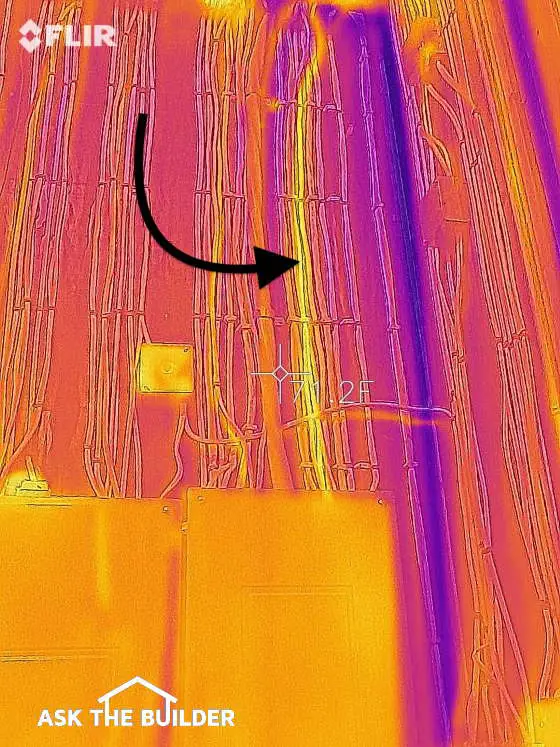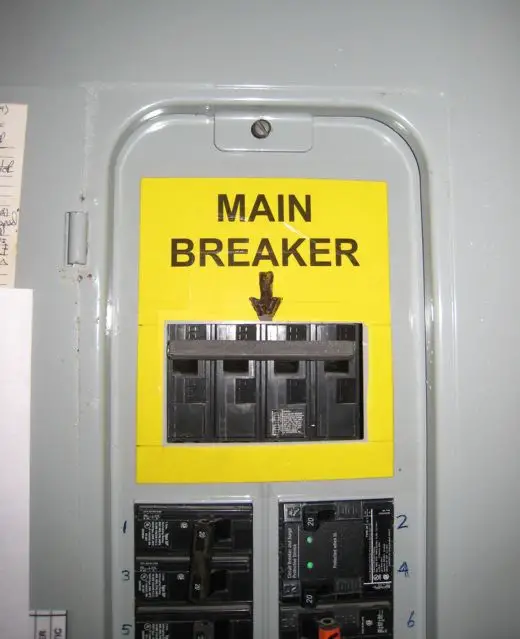Electrical Fire Prevention in Your Home

Electrical Fire Prevention | This infrared photo clearly shows two electric cables that are much warmer than the others. Is this dangerous? Copyright 2021 Tim Carter
Electrical Wiring Question
A few days ago, Marcus asked me an electrical wiring question while I was doing one of my new live streaming video broadcasts. Live streaming video is so much fun because I get to interact with you in real-time just as if we were sitting at a table enjoying a lemonade or iced tea. Each of my live streams is recorded so if you can’t watch it live, you can replay it later.
Marcus’s situation is such that I can see it happening at your home. It’s an extremely important teaching moment in case you don’t know much about how the electricity in your home works and how dangerous it can be if not installed correctly. It’s important to realize that while electricity is a very nice thing to have in a home, it must be respected.
Why Did the National Fire Protection Agency Form?
I went to the National Fire Protection Agency (NFPA) and discovered that hundreds of people die each year in the USA from electrical fires. Thousands are injured. Well over $1 billion in direct property damage is attributed to electrical fires in any given year. This should put your head on a swivel.
The NFPA has a rich history but when you boil it down, it was the insurance industry that created it. The insurance companies realized it was important to educate people like you and me as to how fires could be prevented. As electricity became available in homes, the insurance companies saw that they had to do their best to make sure the electric wires and cables in homes were safe and fires kept to a minimum.
Who Authors and Publishes the National Electrical Code?
The National Electrical Code (NEC) was born of this initiative. The NFPA publishes the NEC. It’s a time-tested document that outlines the minimum standards by which electricity should be installed in your home, businesses, and all buildings for that matter.
Are There Different Wire Sizes in My Home?
How does this relate to you and Marcus? Marcus wanted to know if he could mix and match different wire sizes on the same circuit. You need to know that the wires inside the cables in your home come in different sizes much like shoes or t-shirts. The size is referred to as the wire gauge. The most common wire gauges used in residential houses in the USA are 14, 12, and 10. It can be confusing because as the number gets smaller, the diameter of the wire gets bigger!
The wire size, as well as the insulation that covers the bare wire, has been tested and rated by the NFPA. For example, 14-gauge wire is rated for 15 amps or 1800 watts in the USA. The 12-gauge wire is rated for 20 amps or 2400 watts. The wire powering your electric clothes dryer is almost always a 10-gauge wire. What’s more, your electric dryer runs with 240 volts whereas most of all the other things in your home are running on 120 volts.

These are circuit breakers. Look down at the #2 one any you'll see the number 20. This means it's a 20-amp breaker and a 12-gauge wire should be attached to it.
Hang in there with me. Here’s the payoff. If you go to your electric panel, you’ll probably see these funny levers that are circuit breakers. The breaker is really much like a wall switch you use to control a ceiling light. The breakers are rated by amps and you can see that number on the actual breaker. Look at yours. You’ll see lots of 15s and 20s.
What are the Different Circuit Breakers?
Most of the breakers in your panel will be single-pole breakers. A single wire is connected to the base of the breaker. In a normal circuit in your home, this wire leaves the panel and starts to daisy-chain to wall outlets and possibly a few lights. If the breaker is rated for 20 amps, then the wires on that circuit should be 12 gauge. You’d never ever want a piece of wire in that 20-amp circuit to be 14-gauge wire.
What Do Circuit Breakers Protect?
Here’s why. Normal circuit breakers are designed to protect the wires and cables in your house. There are special breakers like GFCIs that are made to prevent you from being electrocuted but let’s just concentrate on normal breakers.
Why will a Breaker Turn Off Automatically?
The breaker is designed to automatically shut off or trip if it senses too much electricity flowing through the breaker. The more electricity that flows, the greater the heat build-up along the wire. If you put too much electricity through a wire, it can get so hot that it will melt the plastic insulation covering the metal wire and actually ignite it!
I witnessed this at a friend’s house several years ago. They unknowingly plugged in a space heater that drew lots of electricity into a wall outlet that was controlled by a dimmer switch. The dimmer switch was only rated for 600 watts of electric flow. The heater drew 1500 watts. Luckily, my friend’s wife was in the room and saw smoke starting to come out of the wall switch. The dimmer switch was seconds away from starting on fire. They quickly went to the electric panel and switched off that breaker thus preventing a house fire. What would have happened had they turned on the heater and gone to a restaurant for breakfast or gone to sleep?
PLEASE look at the photos of the melted dimmer switch. They should put your head on a swivel.
If a circuit breaker in your home is constantly tripping, it’s SCREAMING to you that something is wrong. You could be drawing too much current. You need to call in an electrician and find out what is going on before you or your loved ones become a statistic.
Are Extension Cords Safe?
You need to use extreme care using extension cords. Visit the NFPA’s website and immerse yourself in any and all consumer educational materials they offer. Get up to speed on how the invisible electricity in your home works. It’s well worth the time.
How Do You Size Extension Cords?
Watch this video:
Column 1429